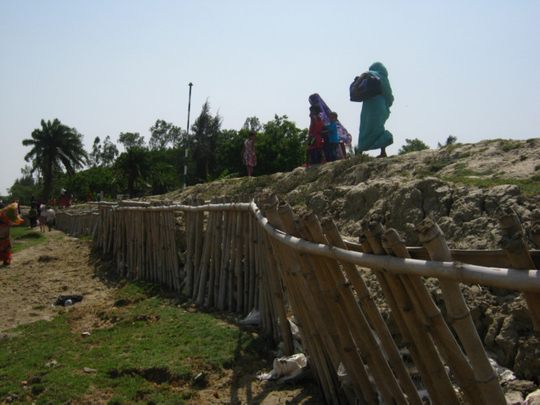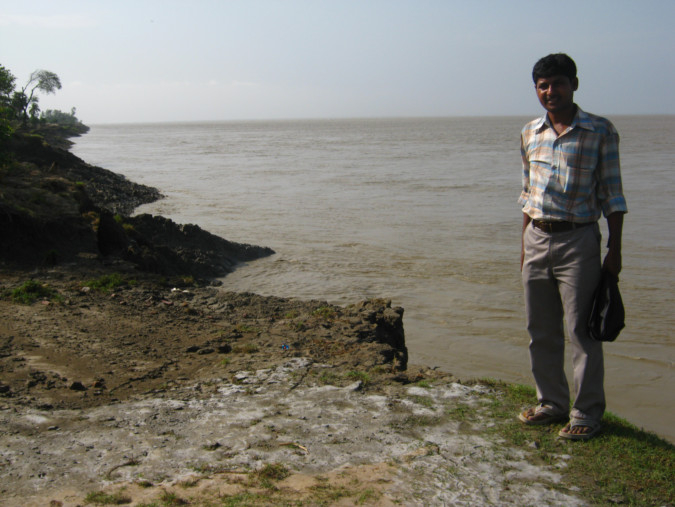
“Has the vessel left for Ghoramara?” asks a woman in a green salwar kameez, wearing outsized sunglasses. The ferry guard tells her it’s yet to arrive. She looks at a group of three women waiting behind her, “Let’s wait, have some cha.” They walk across to a tea shack on the jetty, struggling to hold on to their umbrellas against the strong wind. It’s 9am and already the day is unbearably hot and humid.
This is Harwood Point or Lot 8, the ferry point at Kakdwip to Sagardwip and Ghoramara — two islands on the Sunderbans delta in the Bay of Bengal. Over a cup of tea, we — fellow passengers to Ghoramara — get to know each other. Three of the women are teachers who traverse the waters every day to the government school in Ghoramara. The fourth is a health worker.
Soon, the guard calls out that the ferry has arrived. We walk across with a crowd to see a trawler. The women peer anxiously at the rather small vessel lurching violently on the river. “I am not getting on this,” says the woman in green. “What happened to the regular launch?”
“Probably gone for repairs,” the ferry guard says. The rest of the crowd surges past, getting into the vessel, but the anxious women huddle. “Can’t trust that little trawler to take us across safely,” they say. “There have been several accidents on the Bay.”
I wonder if I should make the trip if such seasoned travellers are having second thoughts. Once again, they hit the tea shacks to make a series of calls to people telling them about their absence. I decide to wait for the next ferry which is nearly three hours later.
Snigdha Shashmal, the health worker, decides to wait for a boy who is coming from Ghoramara with a complication from an injection on his leg. “He will have to be taken to the Sagardwip hospital,” she says. “It’s weird how the doctors in Ghoramara can’t even get an ordinary injection right.”
Shikta, a government school teacher, is bound for Sagardwip. She tells us about schools there being flooded and destroyed every year, like the one in Boatkhali. “That area is sinking too. People keep moving out. But where will they all go?”
I am going to Ghoramara to see the impact of climate change in this rapidly sinking landmass on the Muriganga river, 150 kilometres south of Kolkata. It is among the 54 islands of the Sundarbans, where a significant area of arable land and coastal stretches are being destroyed, leaving thousands homeless as “environmental refugees”.
The island is receding at a rapid pace — reports say that over the past 25 years, more than 51 per cent of the island has been washed away since 1972, and it could disappear by 2025. The receding land forces villagers to rebuild homes further and further inland.
A man in a yellow batik shirt looks at me curiously. “You headed to Ghoramara?”
He is amused to hear that I passed up the 9.15am ferry because the river was rough. “We navigate those waters every day,” he says. “I am from the island. I have some bank work to do. There’s nothing there, you know. We have to come to the mainland — Kakdwip — for everything.”
Narayan Patra’s wife is an Integrated Child Development Services (ICDS) worker in Ghoramara. “Most people are educated, they have completed class 10 — we have 91 per cent literacy in Ghoramara,” he says.
Soon a motley group joins us at the tea shack. Everyone is singing paeans to the island. The soil is fertile, the people are good — everyone (“Hindus and Muslims”) co-exists peacefully. There’s no crime. The air is clean. It is a great tragedy, they say, that no one is able to save the island. The people who have money have bought land and built homes in nearby places such as Sagardwip and Kakdwip. Some have been relocated by the government. The rest — about 5,000 to 6,000 families — are clinging on to hope that the island will somehow be saved. “It is our motherland,” they say. “But we need to think of the future now,” says Patra.
Three hours have passed and the trawler is back. The boat gets packed pretty fast, people sitting perched on both edges and on the floor planks. We begin crossing the Muriganga, a side stream of Ganges that connects the island to Kakdwip.
My fellow passengers tell me about the past: “In all of Sunderbans, Ghoramara is the highest ... It was the first to be inhabited ... The post office and police station of Sagardwip were located here earlier. It was a palatial building, the post office — built by the British. It is now under water. They built a new one.”
There’s no police station in Ghoramara now. People have to take the boat (a journey that takes 45 minutes to an hour) to get grocery, go to the bank, or visit a hospital or a doctor. The situation is particularly disturbing for women. There’s no provision for safe childbirth. There have been instances when women have given birth on the ferry. Sometimes the ferry is needed in the middle of the night and then you are at the mercy of ferry drivers.
Satyajit Meta, a young worker with the “gram panchayat” (local governance body) in Ghoramara, says though the panchayat has been doing everything it can to fight erosion, some parts of the island cannot be salvaged and their inhabitants will have to be shifted soon. He points to a narrow emerald strip on the river.
“That is new land being formed. It is visible when the tide is low. Perhaps it will be habitable soon,” he says. The discussion turns to tides, currents and silt that shape the changing boundaries of land and sea.
“The extension of the Haldia port by the state government has been turning the water towards the island,” says Bhaskar Das, who works with a self-help group in Sagardwip. He is referring to the project that was implemented in the 1970s by the state government despite warnings of increased frequency of tidal floods. In fact, some experts say it is actually the lack of proper dredging that is behind the submerging of the islands. They say Lohachara and Bedford islands disappeared due to this reason.
Apart from the threat of rising sea levels due to climate change, lack of proper dredging undertaken by the Kolkata Port Trust has been blamed for coastal erosion, Das says. Also, because of the Farakka barrage and irrigation canals upstream, sediments are now deposited further upstream instead of compensating erosion in the sea-facing islands.
“The erosion started in the early 1980s,” says a man sitting next to Das. “That is when the port trust started an underwater bund, diverting the Kolkata-bound shipping route. The waves created by the ships started eroding the islands. Things may have worsened due to climate change.”
The trawler draws up at Ghoramara. People get off via a makeshift wooden plank. We walk across an insubstantial embankment, the only wall between the mighty waters and the village. The island is beautiful — a small settlement of thatched mud huts and bamboo stalls and shacks. It is so quiet that all you hear is the breeze and leaves rustling. Some people are sorting the harvested paddy. Kids play in open areas.
One can see the remains of mud houses, destroyed coconut fronds and rotting wood. The water sometimes creeps up stealthily in the night. “It is frightening,” says Meta. “You don’t know when the land under you will give way.”
There are ducks in dug-out ponds. Cattle and goats are tied up in front of houses. I come across a few abandoned buildings and boats, and greenhouses for betel plants made with old sarees and nets tied around poles.
The livelihood of the islanders is mostly betel nut cultivation, fishing and prawn seed collection. Paddy is grown too. The islands are highly fertile due to alluvial deposits but farmers are scared of the “nona jol” (saltwater) that inundates their lands.
Mangroves once grew here but these were cut to allow farming. This has had a devastating effect as they were a binding element for the soil. Frequent flooding by saline water affects the soil quality and the fishing ponds.
I come across a school — the Ghoramara Milan Vidyapeeth — one of the few concrete buildings here. “This is one of the places where families take shelter when the island is flooded,” says Meta. It has six teachers for more than 500 students. According to the 2011 Census, literacy rate of Ghoramara was 91.02 per cent compared to 76.26 per cent of West Bengal.
The Sundarbans mangrove forest is one of the largest of its kind in the world at 140,000 hectares, according to a report by Unesco. It is adjacent to the border of India’s Sundarbans World Heritage site. The trees are young, cut by an intricate network of streams and tributaries that straddle the border between India and Bangladesh.
The depletion has a long history — it began 150 years ago with the arrival of the British, when people settled here in pursuit of timber. Half of the islands have lost their forest cover as the population grew.
The rising sea and destruction of forests threaten the Sundarbans and its most well-known inhabitant, the royal Bengal tiger. The Intergovernmental Panel on Climate Change (IPCC) says the ecology and people of this river delta system are among the most vulnerable in the world.
Villagers frequently lose their land, homes, cattle and even family and friends to the waters. “I had 10 bighas [about 1.6 hectares] of land once,” says Shaikh Esar, an elderly man. “I am left with only three bighas. The rest is in the river.”
Shaikh Khadim, a landless farmer, now lives on the island’s edge. He lost all his land and his home twice, and fears that the river might swallow his new house too. “We are tired of running, living in constant fear. There is no hope for us in Ghoramara,” he says.
“This island is vanishing right in front of our eyes,” says Ajay Patra, former head of the gram panchayat. We are in his house, where he sits on a bed under a canopy of folded mosquito net.
Patra once owned 2,900 bighas of land, but lost much of it. “Most people now work as daily wage labourers under the NREGA Act, a law that guarantees right to work and livelihood security in rural areas. In Ghoramara, the workers build brick roads and the embankments that get washed away. Many people have left for other states such as Kerala,” says Patra. “The people of Kerala leave for Dubai looking for work; our people fill the gap.”
What are the trophies for? I ask pointing to the huge brass structures on his table. His eyes light up. “I was a sportsman. I played football and kabaddi.” He recounts days spent organising tournaments and putting together jatras (folk theatre). “We had a life then. Now it is only about survival. There’s a saying here — ‘aagey baagher shongey juddho korey aamra baachiyachhi, ekhon nodir shaathey lodai korey bechey aachhi’ (‘earlier we fought the tigers and lived, now it is the river we fight and survive’).”
Anuradha Sengupta is a writer based in Mumbai.













